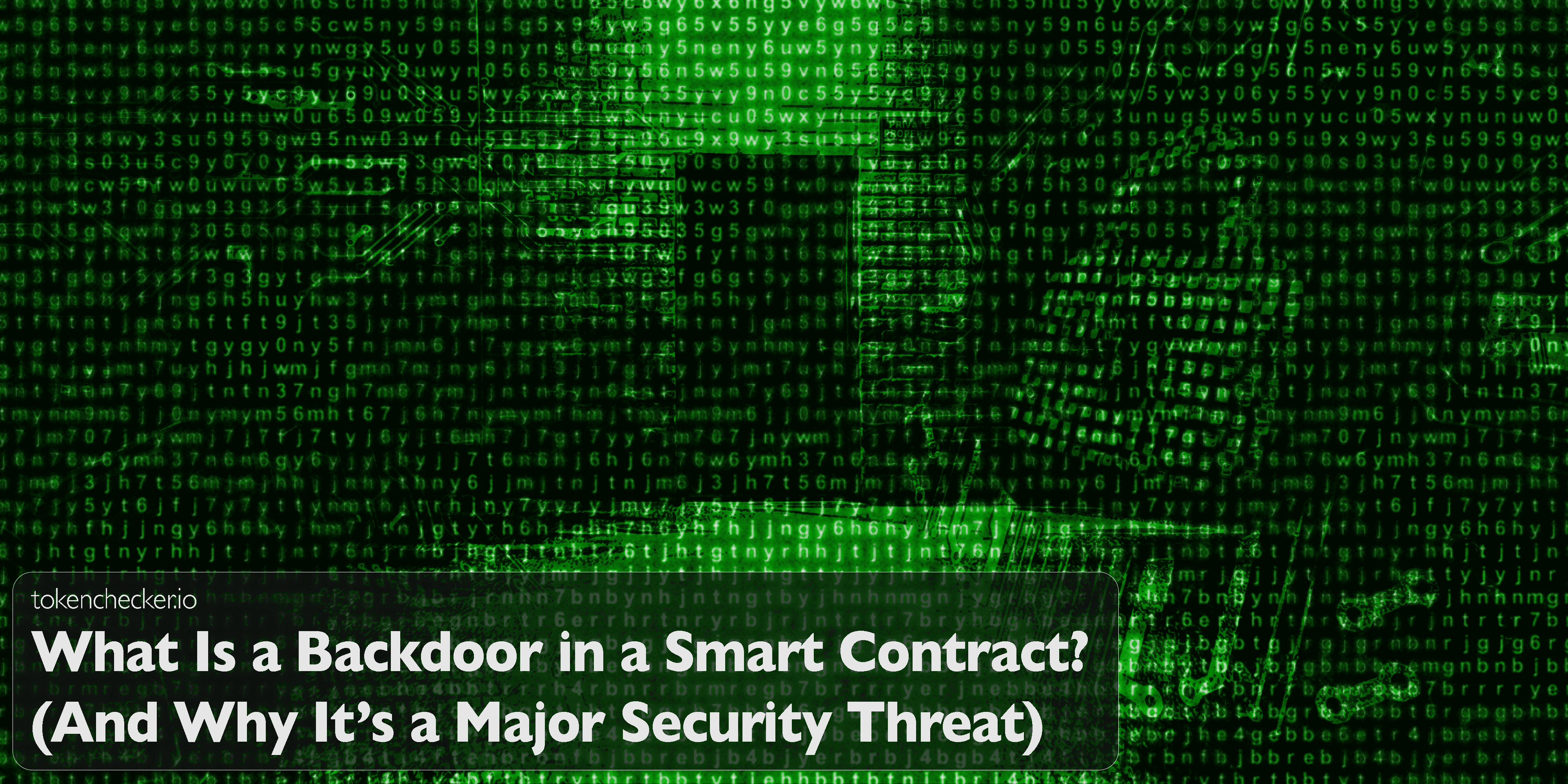
What Is a Backdoor in a Smart Contract? (And Why It’s a Major Security Threat)
Smart contracts are supposed to be trustless—automated pieces of code that execute transparently, without bias, and without interference. But what if that very code hides a secret? That’s the danger of a backdoor: malicious logic deliberately inserted into a smart contract to give the developer hidden control long after launch.
Backdoors are not bugs. They’re not mistakes. They’re traps crafted to look clean while holding the power to drain your funds, block your trades, or destroy the contract entirely. In this article, we’ll break down what smart contract backdoors are, how they work, how scammers hide them, and how tools like tokenchecker.io help you detect them before it’s too late.
What Is a Smart Contract Backdoor?
In general cybersecurity, a backdoor is a hidden way into a system—one that bypasses normal protections. In smart contracts, a backdoor is a function or mechanism that allows the contract creator to:
- Mint unlimited tokens
- Steal user funds
- Freeze wallets or block transfers
- Destroy the entire contract
These functions are usually buried deep in the code, disguised with misleading names, hidden behind proxy contracts, or timed to trigger only after launch. And because smart contracts are immutable, once deployed, these backdoors can’t be removed.
Why They’re So Dangerous
Backdoors violate everything smart contracts are supposed to stand for:
- Trustlessness? Gone. A single dev holds the keys.
- Transparency? Not when functions are disguised or hidden.
- Immutability? Makes the malicious logic permanent.
And once activated, there’s no admin to call. No refund. No rollback. Unless the whole blockchain forks—like what happened after The DAO hack.
Common Types of Smart Contract Backdoors
These are some of the most dangerous backdoor patterns:
| Type | What It Does |
|---|---|
| onlyOwner abuse | Lets the dev mint tokens, withdraw funds, or block transfers |
| selfdestruct() | Wipes the contract and sends funds to the dev wallet |
| delegatecall | Executes code from a different contract, often unverified |
| Mutable flags | Lets dev freeze tokens or disable transfers at will |
| Dynamic metadata edits | Used in NFT rugpulls to replace metadata after mint |
| Hidden mint or burn | Silently inflates or deletes tokens |
| Transfer blockers | Blocks selling based on wallet address or condition |
| Time-delayed triggers | Logic only activates after audits or after hype sets in |
None of these functions are inherently evil—but when misused, they let scammers steal from investors while appearing legitimate on the surface.
Real-World Backdoor Exploits
- The DAO (2016): Reentrancy vulnerability used to drain $60M
- Punk Protocol: Delegatecall allowed remote control of the contract
- SnowdogDAO: Logic allowed insiders to rug pull liquidity
- BEC Token: Integer overflow dropped price to zero
- AnubisDAO: Dev-controlled funds vanished with no warning
These weren’t just technical errors—they were examples of how hidden logic can destroy trust and value in seconds.
How Developers Hide Backdoors
Scammers use clever tricks to hide malicious code:
- Misleading names: A function called safeWithdraw() that actually drains funds
- Split logic: Functions are scattered across contracts, hidden in proxies
- Access control manipulation: Using tx.origin instead of msg.sender to trick wallet logic
- Time-based traps: Code activates after 24 hours or a certain block number
- Crowdsourced audit evasion: Obfuscated logic that passes basic checks
This is why so many “audited” contracts still get exploited. Most audits don’t catch deception—they only catch mistakes.
How to Detect Smart Contract Backdoors
1. Read the Contract
Search for functions like mint, burn, setOwner, delegatecall, selfdestruct, and any suspicious modifiers like onlyOwner. If you don’t understand what they do, walk away. Our guide on how to read smart contracts can help.
2. Use tokenchecker.io
tokenchecker.io runs deep scans that:
- Flag dangerous functions
- Simulate sell actions (honeypot test)
- Analyze mint permissions
- Check liquidity lock status
- Detect proxy delegation and hidden control
Its Contract Analysis and Rug Pull Detection systems are built to find what most audits miss.
3. Watch the Creator Wallet
If the dev is minting tokens, transferring liquidity, or dumping early—this is the red flag of all red flags. tokenchecker.io’s Creator Wallet Monitoring makes it obvious.
Final Thoughts
Backdoors are the silent killers of DeFi. They hide in plain sight, waiting to be triggered. And once they activate, there’s no undo button.
That’s why every serious investor should treat contract analysis like due diligence. Use tools like tokenchecker.io. Learn how to spot deceptive patterns. And never assume a project is safe just because it looks polished or has a community.
In a space where code is law, the real law is the logic you didn’t read. Don’t trust. Verify.